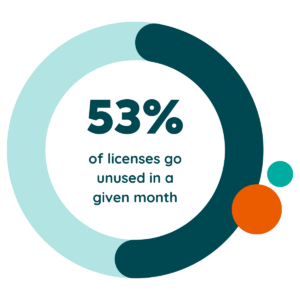
‘Oh Shit’ Moments that Validate the Need for SaaS Management
Table of Contents ToggleOh Shit! I’m Wasting MoneyOh Shit! We Have...
Back
Back
Search for Keywords...
Blog

Table of Contents
Ignited by the pandemic, and fueled by the pivot to hybrid and remote work, SaaS growth continues to explode and shows no sign of slowing down.
Following another year of record-breaking growth, Gartner now predicts worldwide end-user spending on SaaS to grow 19% to total $299B in 2025. That’s up from $247B in 2024.

“There is no business strategy without a cloud strategy,” said Milind Govekar, distinguished vice president at Gartner. “The adoption and interest in public cloud continues unabated as organizations pursue a ‘cloud-first’ policy for onboarding new workloads.”
And it’s not just SaaS providers experiencing record growth. With remote work on the rise, organizations increasingly turn to SaaS to power the new digital workplace.
According to Bessemer’s State of the Cloud Report for 2022, over 90% of CIOs expect to spend the same or more on IT in the next three years, with nearly half planning to increase spend.
Cloud-based software will become the most dominant form of software within the next few years — and with many purchases occurring outside of IT and procurement — you need to consider SaaS Management.
Read on to learn some of the key benefits as we help you make the business case for adopting SaaS Management at your organization.
SaaS Management is the holistic business practice of proactively managing, optimizing, and governing all the SaaS applications within a company’s portfolio through inventory, license, and renewal management. It is founded on four tenets: complete visibility, license optimization, cost savings, and risk avoidance.
In short, SaaS Management allows you to unlock the full value of your SaaS investments by discovering your full stack and spend, revealing utilization and license data, and informing contractual and renewal terms.
Effective SaaS Management in the digital age requires continuous oversight and real-time analysis. Relying on manual processes and Excel spreadsheets won’t cut it.
To truly get the upper hand on your (likely) sprawling SaaS library, bring technology into the mix and consider a SaaS Management platform.
If you’re unsure about making the business case for SaaS Management, take comfort in knowing it’s not another point solution, but rather a game-changing strategy for your organization. Even in times of increasing costs and inflation, there’s an undeniable business case to SaaS Management.
When you proactively manage and optimize your SaaS, your organization saves money, reduces risk, and delivers a better employee experience. Essentially, it’s a win-win-win situation.
Zylo’s SaaS Management Index shows 53% of all SaaS licenses go unused in a 30-day period, and on average organizations waste $21M of dollars each year in unused SaaS.
 With a SaaS Management platform, you can identify all of the unused applications lingering in your tech stack and make rationalization decisions to determine which tools should remain in use, and which need replacement, consolidation, or retirement. SaaS Management also saves money by preventing auto-renewals, and providing key data to negotiate additional features and better contract terms.
With a SaaS Management platform, you can identify all of the unused applications lingering in your tech stack and make rationalization decisions to determine which tools should remain in use, and which need replacement, consolidation, or retirement. SaaS Management also saves money by preventing auto-renewals, and providing key data to negotiate additional features and better contract terms.
Consider how Talkdesk realized $350,000 in annual savings, completed 24 contract negotiations, and recouped their SaaS Management ROI in just a few months after partnering with Zylo.
But prior to using a SaaS Management platform, Talkdesk lacked established processes. Instead, SaaS purchase and renewal negotiations were typically led by business owners — and there was no central oversight in the organization.
“SaaS spending was taking place via different avenues. Having visibility into all of our spending is important, and bringing all of these purchases into one central location is key,” says Gordon Atkin, former Vice President, Global Systems and Technology at Talkdesk.
How Talkdesk Streamlines SaaS Negotiations for Better Outcomes with Zylo
Discover how Talkdesk’s IT and procurement teams use Zylo to improve SaaS negotiations and cross-functional collaboration, while saving time and money.
Today, the average organization pays for 269 SaaS tools. So, you may be wondering “How did we get here?” The reality: SaaS is relatively inexpensive, super-easy to download, and often purchased by individual employees or business units. In fact, Zylo data shows that nearly one in 15 (6.6%) employees expenses SaaS.

Allowing automation and flexibility enables employees to work efficiently and use their preferred tools, but a lack of central oversight invites shadow IT and increases the risk of costly security and data breaches. In the U.S., the average cost of a data breach is $4.88M, including mitigation efforts and lost business.
A SaaS Management platform provides full visibility into your SaaS sprawl, including shadow IT and tools not known to SSO, to ensure compliance with all applications.
And with full visibility of your tech stack, you can curate a library of pre-approved SaaS, then allow employees to select their favorite tools, also known as freedom within a framework.
Evolving Your SaaS Governance Framework for the Digital Workplace
Learn MoreSpeaking of freedom within a framework, it’s important to note this isn’t the latest HR buzzword. Data shows that allowing workers to choose their preferred SaaS helps to attract and retain top talent.
According to a recent study, 89% of workers said they would take a pay cut in order to use their preferred technology, while 70% said they would be more likely to join a company if they were able to choose their own technology.
Additionally, as more employees pivot to remote and hybrid work, cloud-based software will play a greater role in driving collaboration in a distributed workforce.
For instance, Software provider Atlassian partnered with Zylo to establish a cloud governance strategy for its 4,500 remote workers. After discovering their complete software inventory, including employee-purchased SaaS, Atlassian built a pre-vetted library of best-in-class tools and gave their employees the freedom to pick their favorite tools.
“We want to drive innovation, and it’s happening at light-speed. We want the business to be enabled, and we achieve that by partnering with our stakeholders to find the best possible solutions.”
– John Stame, former Senior Enterprise Architect for Atlassian IT
Ready to make the business case for SaaS management at your organization? Schedule a personalized demo to see Zylo in action, and to learn how SaaS Management can save your organization money, improve security, and boost the employee experience.

Table of Contents ToggleOh Shit! I’m Wasting MoneyOh Shit! We Have...

In the past 4 years, Adobe has rapidly scaled from $9B to $18B. This growth has made an already complex environment even more complex. Learn how they leveraged Zylo to get complete visibility into their SaaS portfolio, unlock millions in cost savings and avoidance and improve the employee experience.

Discover how Marigold unlocked the door to nearly $1M in SaaS cost savings with Zylo, while undergoing a M&A tech integration and cutting software waste from their portfolio.
| Cookie | Duration | Description |
|---|---|---|
| cookielawinfo-checkbox-analytics | 11 months | This cookie is set by GDPR Cookie Consent plugin. The cookie is used to store the user consent for the cookies in the category "Analytics". |
| cookielawinfo-checkbox-functional | 11 months | The cookie is set by GDPR cookie consent to record the user consent for the cookies in the category "Functional". |
| cookielawinfo-checkbox-necessary | 11 months | This cookie is set by GDPR Cookie Consent plugin. The cookies is used to store the user consent for the cookies in the category "Necessary". |
| cookielawinfo-checkbox-others | 11 months | This cookie is set by GDPR Cookie Consent plugin. The cookie is used to store the user consent for the cookies in the category "Other. |
| cookielawinfo-checkbox-performance | 11 months | This cookie is set by GDPR Cookie Consent plugin. The cookie is used to store the user consent for the cookies in the category "Performance". |
| viewed_cookie_policy | 11 months | The cookie is set by the GDPR Cookie Consent plugin and is used to store whether or not user has consented to the use of cookies. It does not store any personal data. |
